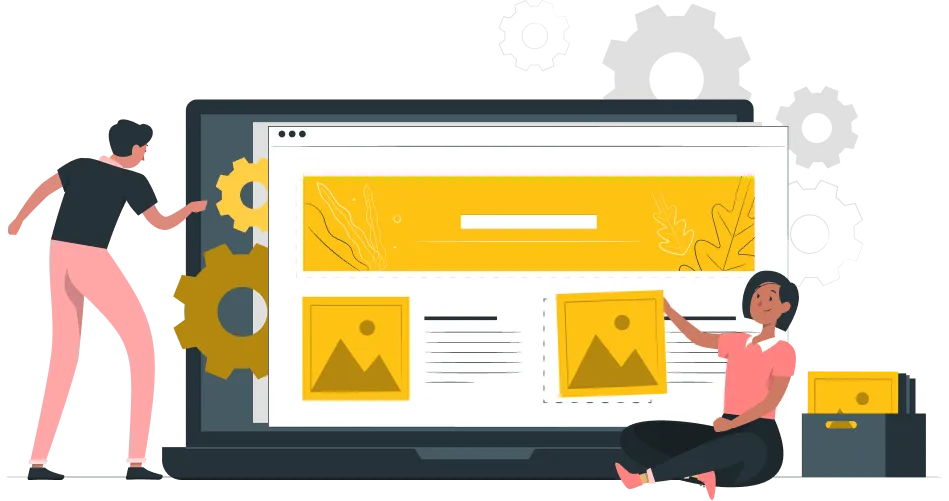What is No-code Development?
No-code development is a revolution in the creation of digital products. Thanks to intuitive visual tools and ready-made templates, anyone, regardless of technical skills, can create their own website or web application. The process of creating an application is quick and does not require significant resources..
What is No-code?
First, you need to understand what no-code development is. It is an innovative approach to creating websites, mobile applications, and other digital products without writing code. Instead of composing complex lines of code, you use visual elements, pre-designed blocks, and an intuitive interface to build your projects. In no-code development, you work with graphical elements that you can drag, drop, and customize. No-code platforms offer a wide range of ready-made functionality blocks, such as forms, payment systems, maps, and more. Application logic is defined using visual tools, eliminating the need to write algorithms. The main benefits of no-code development include:
- Speed: Product creation takes significantly less time compared to traditional development.
- Accessibility: No deep technical knowledge is required to implement projects.
- Flexibility: The ability to quickly make changes accelerates development times.
- Cost-effectiveness: Lower development costs help optimize overall expenses.
- Focus on the Idea: You can concentrate on product creation without being bogged down by technical details.
No-code development is a powerful tool that allows you to bring ideas to life without needing programming skills. This makes the creation of digital products more accessible and democratic, enabling the implementation of projects of any complexity.

Who Needs No-code Development?
No-code development is a powerful tool that opens up new opportunities for a wide range of people. It can be useful for:
- Entrepreneurs and Startups: No-code allows for the rapid creation of a minimum viable product (MVP) to test ideas in the market and attract investment. Products can easily be adjusted to meet the individual preferences of the target audience. Additionally, there is no need to hire a large development team in the early stages, which significantly optimizes costs.
- Marketers and Designers: No-code facilitates the quick creation of effective landing pages for advertising campaigns, enabling the rapid launch of new products with minimal costs. Designers can use no-code tools to develop interactive prototypes for user testing. These solutions can also generate personalized marketing materials efficiently.
- Small and Medium-sized Businesses: No-code development helps automate routine tasks, enhance operational efficiency, and optimize workflows. Businesses can create custom web applications without needing programmers, resulting in cost-effective and timely solutions. For example, an online store for goods or services can be launched quickly on a minimal budget to meet urgent business needs.
- Students: No-code tools can help students learn the basics of programming and web development interactively and cost-effectively. Students can also build portfolios while studying, which is invaluable for job applications. Additionally, no-code fosters creative thinking and problem-solving skills, enabling students to realize their potential faster.
- Non-profit Organizations: Non-profits can use no-code platforms to develop websites and other digital tools to promote their ideas and raise funds. Educational institutions can create comprehensive learning platforms that meet modern standards to teach people new skills.
- Freelancers and Agencies: Freelancers can use no-code tools to offer new services, such as prototypes and MVPs, to help clients better understand consumer needs. Projects can be completed more quickly and at a lower cost since there is no need to hire additional developers.
No-code mobile app development may be required in various cases. It is ideal for quickly testing an idea and gathering feedback from users. Additionally, this development approach is well-suited for small projects. When hiring a team of developers is not feasible and the budget is limited, no-code provides an excellent solution, enabling the creation of a minimum viable product. If the product requires frequent adaptation to changing market demands, this development approach is also worth considering. While no-code is an excellent solution for rapid prototyping, MVPs, and small-scale web applications, it is not a replacement for traditional development. Large, complex projects requiring high performance, scalability, and extensive customization still rely on professional developers. However, no-code expands the possibilities for creating digital products, making development accessible to a broader audience and fostering innovation across various fields.
Where to Find No-Code Developers and How to Work with Them
No-code application development opens up new opportunities for creating digital products without requiring deep programming knowledge. However, if you prefer not to delve into this field yourself, the question arises of how to find a specialist. You can use specialized freelance platforms like Upwork, Freelancer, Fiverr, and others. On these sites, you'll find many professionals specializing in no-code development. You can review profiles, portfolios, and client reviews to select a suitable candidate. Additionally, there are platforms specifically focused on no-code development, where you can find specialists experienced in tools such as Bubble or Webflow. Social media can also be an effective tool for finding professionals. Use LinkedIn to search for specialists with keywords like “No-code developer,” “Bubble developer,” and others. Join groups dedicated to no-code development to ask questions and find experts. Attending conferences and meetups focused on no-code development is another excellent way to connect with potential collaborators. To ensure smooth collaboration and protect your interests, establish a contract with the developer. You can choose between hourly payment, a fixed rate, or payment based on deliverables. Regular communication is essential to avoid misunderstandings and accelerate the development process. Be prepared for potential changes to the project scope or technical requirements as new ideas or needs arise. Working with a no-code development specialist involves considering many nuances. Clearly define your project requirements and budget. Review the candidate's previous work and communicate with them to ensure they understand your needs and possess the necessary skills. Request regular progress updates from the developer. Verify that intermediate results align with the project specifications. Actively participate in the process and provide timely feedback. For successful collaboration, approach the project with a high level of responsibility.

How to Implement a No-Code Approach
Implementing a no-code approach can significantly accelerate product development and enhance your team’s efficiency. The no-code creation of applications and websites involves several key stages:
- Defining Goals and Objectives. Identify the processes or tasks that can be automated or improved using no-code tools. Select projects that will provide the greatest benefit to your business in both the short and long term. Set criteria to evaluate the success of the implementation. Analyze all relevant data to guide your next steps.
- Choosing the Right Platform. Based on your goals and objectives, choose a platform with the necessary functionality. Compare different platforms considering factors like cost, ease of use, integration with other systems, and the availability of support. Start with a small pilot project to assess the platform’s effectiveness in practice.
- Employee Training. Determine the most effective training format for your team (e.g., webinars, workshops, or self-study). Create clear and accessible training materials tailored to employees' knowledge levels. Allow employees to apply their learning practically by developing small projects.
- Creating a Centralized Knowledge Base. Develop detailed documentation on using the chosen platform and the applications created. Provide templates for common application types and build a library of reusable components for various projects.
- Implementation into Work Processes. Facilitate the seamless integration of no-code applications with other systems used in your company. Establish working groups responsible for the development and support of no-code applications. Encourage employees to propose ideas for new applications and actively participate in the development process.
- Continuous Development. Regularly evaluate the outcomes of using no-code tools and make necessary adjustments. Train new employees to maintain the team’s knowledge level. Keep track of platform updates and incorporate new features when applicable.
It’s important to note that challenges can arise when using no-code tools, especially in mobile development. Technical inconsistencies may occur when integrating with existing systems, and these should be addressed to optimize processes as much as possible. Involve specialists to resolve such issues.

Which No-Code Services Can You Use to Create Your Product?
No-code platforms provide incredible opportunities to create various digital products without needing to write code. Choosing the right service depends on your specific goals, technical knowledge level, and project scale. Here’s a look at some popular platforms that can help you build your website or app in just a few days:
- Bubble. One of the most powerful and flexible platforms for creating web applications and websites without code. Bubble allows you to develop complex dynamic applications with databases, user interfaces, and integrations with other services. It is suitable for developers, designers, and entrepreneurs who want to build scalable web applications.
- Webflow. Ideal for creating beautiful and responsive websites without coding. Webflow combines the power of a CMS with design flexibility. It features a visual editor for precise design customization and supports CMS integration for content management. The platform also offers support for animations, interactive elements, and ready-made templates to speed up development.
- Wix. Perfect for building business websites and small online stores. Wix is well-suited for marketers, entrepreneurs, and small businesses needing to quickly create attractive websites. With a large library of ready-made blocks and templates, an intuitive interface, and integration capabilities, Wix helps achieve efficient results during development.
- Adalo. A platform for creating mobile and web applications without coding. Adalo enables you to build apps with user interfaces, databases, and integrations with other services. It is ideal for mobile app developers, entrepreneurs, and startups. The platform supports integration with popular services like Google Sheets and Stripe and allows you to publish finished apps on the App Store and Google Play.
- Flutterflow. Designed for creating native mobile applications for iOS and Android based on Figma designs. Flutterflow quickly converts designs into finished applications. It’s an excellent solution for designers and developers seeking to develop no-code apps with visually appealing user interfaces. The output is high-performance mobile apps with native user interfaces.
Choosing the right platform depends on your budget and preferences. Additionally, consider the platform’s integration capabilities and its potential for scaling as your business grows. It’s advisable to test the functionality of several platforms initially to determine the best fit for your needs.
Let's Sum It Up
No-code development offers an innovative approach to creating digital products, enabling even those without extensive programming knowledge to develop functional websites, applications, and other digital solutions. The main principles of no-code development include:
- Using visual programming tools instead of writing complex code;
- Avoiding complicated technical details;
- Accelerating the development process with visual tools and ready-made components;
- Allowing for easy modifications and experimentation;
- Ensuring accessibility for a wide range of users.
No-code development is a powerful tool that democratizes the development process, empowering individuals and businesses to create innovative digital products. It opens up new opportunities for entrepreneurship and business growth.







